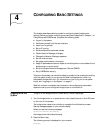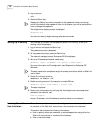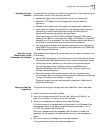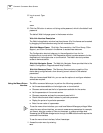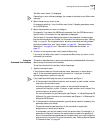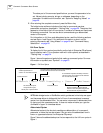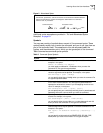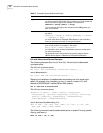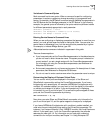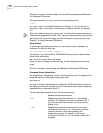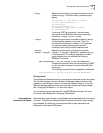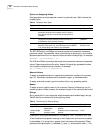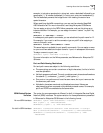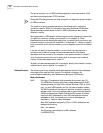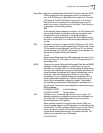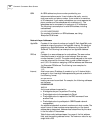
Learning About the User Interfaces 25
Variations in Command Syntax
Each command has its own syntax. When a command is used for configuring
parameters, its syntax or values may change according to the parameter and
service. For example, the SETDefault command sets the NetMapTime parameter in
the SYS Service and the MaxAge parameter in the STP Service. In the following
example, the general syntax is followed by the syntax variations (different values
for different parameters) appropriate to each parameter:
SETDefault <parameter>
= <
value>
SETDefault -SYS NetMapTime = <number>(0 to 120 seconds)
SETDefault -STP MaxAge = <second> (6-40)
Entering Service Names in Command Lines
When you are configuring or displaying parameters that appear in more than one
service, you must provide a service name to distinguish them. You can enter the
service name in abbreviated form, but the name must be preceded by a hyphen.
For example, to indicate BRidge Service, type -BR.
Abbreviated service names are indicated in uppercase in this guide.
There are three exceptions:
■ If you have previously set the CurrentServices parameter to the desired service,
you do not need to enter the service name. The system prompt indicates the
current service if you set a single service with the CurrentServices parameter.
For information on using the CurrentServices parameter, see Reference for
Enterprise OS Software.
■ Environment parameters do not have a service name. For descriptions of these
parameters, see Reference for Enterprise OS Software.
■ You do not need to enter a service name when the parameter name is unique.
Determining the Display of Ports and Virtual Ports
You can control which ports are displayed in the output of the SHow and
SHowDefault commands by setting the CurrentPorts parameter. If you have a
bridge/router with several ports, for example a NETBuilder II bridge/router with
multiport I/O modules installed, you may want to limit the display to information
on certain ports instead of all ports. If you are interested only in displaying
information for port 2 and virtual port V3, as well as the paths mapped to these
ports, set the CurrentPorts parameter by entering:
SET CurrentPorts = (2, V3)
Now when you enter SHow and SHowDefault commands, only information for
port 2 and virtual port V3, and the paths mapped to these ports, is displayed.
If you have a NETBuilder II bridge/router with a multiport module installed, you
must enter its ports individually when setting the CurrentPorts parameter. For
instance, if you have an Ethernet 2-Port 10BASE-FL module, the A and B ports are
distinct. If you specify port 1 with the CurrentPorts parameter, the software
assumes you mean port 1A. For information on port and path numbering
conventions for multiport modules, see Chapter 1 in Using Enterprise OS



